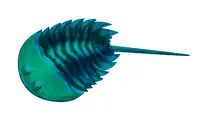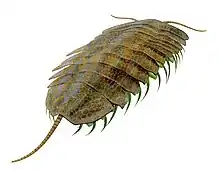Kuamaia
Kuamaia is an extinct genus of artiopodan in the phylum Arthropoda.[1][2] Fossils of the type species K. lata were discovered in the Chengjiang biota. The other species in the genus,K. muricata has also been identified there, but neither species has been found elsewhere.[3]
| Kuamaia Temporal range: | |
|---|---|
 | |
| Drawing of Kuamaia lata | |
| Scientific classification | |
| Domain: | Eukaryota |
| Kingdom: | Animalia |
| Phylum: | Arthropoda |
| (unranked): | †Artiopoda |
| Subphylum: | †Trilobitomorpha |
| Subclass: | †Conciliterga |
| Genus: | †Kuamaia Hou 1987 |
| Species | |
| |
Kuamaia lata was a benthic arthropod[3][4] and a mobile hunter and scavenger.[4] A spiny section on K. lata's legs is presumed to have allowed it to tear apart food.[3]
Morphology
Kuamaia lata has an oval dorsal exoskeleton shape, with a gradual decline from the somewhat elevated medial axis of the animal to the exoskeleton edge. K. lata appears smooth, with little space between tergites and low-profile pleural spines. Some fusion of parts of the exoskeleton is evident, but there is some discussion as to what degree this occurred. The tail segment has three more prominent spines, two being lateral and one axial. The largest fossil K. lata was at least 10 cm long, excluding appendages.[3]
On the underside of K. lata, opposite the dorsal head shield, there is also a ventral sclerite. K. lata appears to have approximately 15 pairs of biramous legs, 3 originating from the head shield, 1 from each of the seven tergites that make up K. lata's thorax, and another 5 from the tail segments.[3]
The ramuses, also known as the exopods of the biramous legs, acted as the gills of K. lata.[5] These gills were made up of many lamellae, which facilitated gas exchange.[5][6] These lamellae were packed together in rows on each exopod. K. lata had a lower number of these, with an average number of 22 lamellae per exopod, compared to an average of 50 in other arthropods.[5]
References
- Stein, Martin; Budd, Graham E; Peel, John S; Harper, David AT (2013-05-11). "Arthroaspis n. gen., a common element of the Sirius Passet Lagerstätte (Cambrian, North Greenland), sheds light on trilobite ancestry". BMC Evolutionary Biology. 13: 99. doi:10.1186/1471-2148-13-99. PMC 3662621. PMID 23663519.
- "Fossilworks: Kuamaia lata". fossilworks.org. Fossilworks. Retrieved 17 December 2021.
- The Cambrian fossils of Chengjiang, China : the flowering of early animal life. Hou, Xianguang. (Second ed.). Chichester, West Sussex. ISBN 978-1-118-89631-0. OCLC 970396735.
{{cite book}}: CS1 maint: others (link) - Zhao, Fangchen; Caron, Jean-Bernard; Bottjer, David J.; Hu, Shixue; Yin, Zongjun; Zhu, Maoyan (2014). "Diversity and species abundance patterns of the Early Cambrian (Series 2, Stage 3) Chengjiang Biota from China". Paleobiology. 40 (1): 50–69. doi:10.1666/12056. ISSN 0094-8373. JSTOR 44017866. S2CID 131526964.
- Suzuki, Yutaro; Kondo, Akiyoshi; Bergström, Jan (2008). "Morphological Requirements in Limulid and Decapod Gills: A Case Study in Deducing the Function of Lamellipedian Exopod Lamellae". Acta Palaeontologica Polonica. 53 (2): 275–283. doi:10.4202/app.2008.0208. ISSN 0567-7920.
- "Respiratory system - Gills of invertebrates". Encyclopedia Britannica. Retrieved 2019-12-05.



